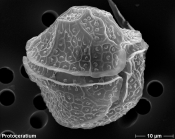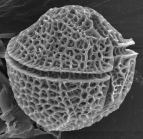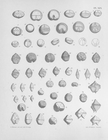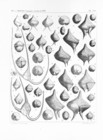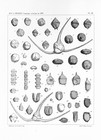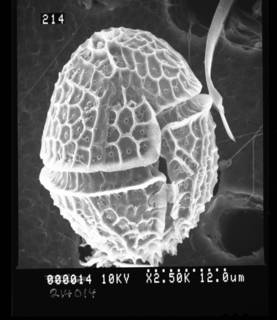WoRMS taxon details
Protoceratium reticulatum (Claparède & Lachmann) Bütschli, 1885
110321 (urn:lsid:marinespecies.org:taxname:110321)
accepted
Species
Gonyaulax grindleyi Reinecke, 1967 · unaccepted (synonym)
Peridiniopsis reticulata (Claparède & Lachmann) Starmach · unaccepted (synonym)
Peridinium reticulatum Claparède & Lachmann, 1859 · unaccepted (synonym)
Protoceratium aceros Bergh, 1882 · unaccepted
marine
(of Peridinium reticulatum Claparède & Lachmann, 1859) Claparède E. & Lachmann J. (1858). Etudes sur les Infusoires et les Rhizopodes. <em>Mém. Inst. Genev.</em> 5, 6: 489 pp. [details]
Type locality contained in North Sea
type locality contained in North Sea [details]
LSID urn:lsid:algaebase.org:taxname:105937
Description Theca polyhedral, slightly longer than broad, epitheca conical, shoulders at boundary of apical/precingular plate series,...
LSID urn:lsid:algaebase.org:taxname:105937 [details]
Description Theca polyhedral, slightly longer than broad, epitheca conical, shoulders at boundary of apical/precingular plate series,...
Description Theca polyhedral, slightly longer than broad, epitheca conical, shoulders at boundary of apical/precingular plate series, hypotheca rounded, slightly larger than epitheca. Mature thecae strongly reticulated, usually with one trichocyst pore at center of each reticulation. Some cells have broad sutural bands ornamented with longitudinal and transverse ridges. Plate formula typically 4’ (or 2’+*2’), 6’’, 6c, *6’’’, 1p, 1’’’’. First apical plate insert, usually with distinct pore on right anterior margin. Fourth apical plate or homolog of significant size (as large or larger than 3’). Sixth precingular plate five-sided with broadly geniculate anterior margin, does not approach a triangular shape, contacts first apical plate. Cingulum slightly anterior to equator, descending with no overhang, displaced ventrally by about one width, with prominent lists. Sulcus straight, reaching almost to antapex. All features of L-type ventral organization consistently present. First postcingular homolog (*1’’’) small, contained within sulcus. Posterior intercalary plate (1p) long, narrow. Antapical plate (1’’’’) six-sided, trapezoidal, with distinctive arcuate inset at contact with posterior margin of sulcus; contact with 1p shorter than with 6’’’. Sexiform hypothecal tabulation, with antapical tabulation weakly asymmetrical (e.g., von Stosch, 1969) or more strongly asymmetrical (e.g., Reinecke, 1967). Plate 3’’ relatively small, approximately centered on dorsoventral midline. Hypotheca usually dextrally contorted to varying degrees, with *4’’’/*5’’’ boundary displaced to left of 3’’/4’’ boundary at cingulum.
[details]
[details]
Guiry, M.D. & Guiry, G.M. (2024). AlgaeBase. World-wide electronic publication, National University of Ireland, Galway (taxonomic information republished from AlgaeBase with permission of M.D. Guiry). Protoceratium reticulatum (Claparède & Lachmann) Bütschli, 1885. Accessed through: World Register of Marine Species at: https://www.marinespecies.org/aphia.php?p=taxdetails&id=110321 on 2024-10-31
Date
action
by
2006-07-27 06:59:07Z
changed
Camba Reu, Cibran
Copyright notice: the information originating from AlgaeBase may not be downloaded or replicated by any means, without the written permission of the copyright owner (generally AlgaeBase). Fair usage of data in scientific publications is permitted.
original description
(of Peridinium reticulatum Claparède & Lachmann, 1859) Claparède E. & Lachmann J. (1858). Etudes sur les Infusoires et les Rhizopodes. <em>Mém. Inst. Genev.</em> 5, 6: 489 pp. [details]
context source (Schelde) Maris, T.; Beauchard, O.; Van Damme, S.; Van den Bergh, E.; Wijnhoven, S.; Meire, P. (2013). Referentiematrices en Ecotoopoppervlaktes Annex bij de Evaluatiemethodiek Schelde-estuarium Studie naar “Ecotoopoppervlaktes en intactness index”. <em>Monitor Taskforce Publication Series, 2013-01. NIOZ: Yerseke.</em> 35 pp. (look up in IMIS) [details]
basis of record Gómez, F. (2005). A list of free-living dinoflagellate species in the world's oceans. <em>Acta Bot. Croat.</em> 64(1): 129-212. [details]
additional source Meunier, A. (1919). Microplankton de la Mer Flamande: 3. Les Péridiniens. Mémoires du Musée Royal d'Histoire Naturelle de Belgique = Verhandelingen van het Koninklijk Natuurhistorisch Museum van België, VIII(1). Hayez, imprimeur de l'Académie royale de Belgique: Bruxelles. 111, 7 plates pp. (look up in IMIS) [details]
additional source Guiry, M.D. & Guiry, G.M. (2024). AlgaeBase. <em>World-wide electronic publication, National University of Ireland, Galway.</em> searched on YYYY-MM-DD., available online at http://www.algaebase.org [details]
additional source Tomas, C.R. (Ed.). (1997). Identifying marine phytoplankton. Academic Press: San Diego, CA [etc.] (USA). ISBN 0-12-693018-X. XV, 858 pp., available online at http://www.sciencedirect.com/science/book/9780126930184 [details]
additional source Brandt, S. (2001). Dinoflagellates, <B><I>in</I></B>: Costello, M.J. <i>et al.</i> (Ed.) (2001). <i>European register of marine species: a check-list of the marine species in Europe and a bibliography of guides to their identification. Collection Patrimoines Naturels,</i> 50: pp. 47-53 (look up in IMIS) [details]
additional source Steidinger, K. A., M. A. Faust, and D. U. Hernández-Becerril. 2009. Dinoflagellates (Dinoflagellata) of the Gulf of Mexico, Pp. 131–154 in Felder, D.L. and D.K. Camp (eds.), Gulf of Mexico–Origins, Waters, and Biota. Biodiversity. Texas A&M Press, College [details]
additional source Moestrup, Ø., Akselman, R., Cronberg, G., Elbraechter, M., Fraga, S., Halim, Y., Hansen, G., Hoppenrath, M., Larsen, J., Lundholm, N., Nguyen, L. N., Zingone, A. (Eds) (2009 onwards). IOC-UNESCO Taxonomic Reference List of Harmful Micro Algae., available online at http://www.marinespecies.org/HAB [details]
additional source Liu, J.Y. [Ruiyu] (ed.). (2008). Checklist of marine biota of China seas. <em>China Science Press.</em> 1267 pp. (look up in IMIS) [details] Available for editors [request]
[request]
additional source Meunier, A. (1910). Microplankton des Mers de Barents et de Kara. Duc d'Orléans. Campagne arctique de 1907. Imprimerie scientifique Charles Bulens: Bruxelles, Belgium. 355 + atlas (XXXVII plates) pp. (look up in IMIS) [details]
additional source Chang, F.H.; Charleston, W.A.G.; McKenna, P.B.; Clowes, C.D.; Wilson, G.J.; Broady, P.A. (2012). Phylum Myzozoa: dinoflagellates, perkinsids, ellobiopsids, sporozoans, in: Gordon, D.P. (Ed.) (2012). New Zealand inventory of biodiversity: 3. Kingdoms Bacteria, Protozoa, Chromista, Plantae, Fungi. pp. 175-216. [details]
new combination reference Bütschli O. (1885). Dinoflagellata. In Protozoa (1880-1889). <em>Bronn‘s Klassen und Ordnungen des Tierreichs.</em> 1: 906-1029. [details]
toxicology source Satake M., MacKenzie L. & Yasumoto T. 1997. Identification of <i>Protoceratium reticulatum</i> as the biogenetic origin of yessotoxin. Nat. Toxins 5: 164-167. [details]
toxicology source Satake M., Ichimura T., Sekiguchi K., Yoshimatsu S. & Oshima Y. 1999. Confirmation of yessotoxin and 45, 46, 47-trinoryessotoxin production by <i>Protoceratium reticulatum</i> collected in Japan. Nat. Toxins 7: 147-150. [details]
toxicology source Paz, B., Riobó, P., Fernández, M. L., Fraga, S. & Franco, J. M. 2004. Production and release of yessotoxins by the dinoflagellates Protoceratium reticulatum and Lingulodinium polyedrum in culture. Toxicon 44:251-58. [details] Available for editors [request]
[request]
ecology source Mitra, A.; Caron, D. A.; Faure, E.; Flynn, K. J.; Leles, S. G.; Hansen, P. J.; McManus, G. B.; Not, F.; Do Rosario Gomes, H.; Santoferrara, L. F.; Stoecker, D. K.; Tillmann, U. (2023). The Mixoplankton Database (MDB): Diversity of photo‐phago‐trophic plankton in form, function, and distribution across the global ocean. <em>Journal of Eukaryotic Microbiology.</em> 70(4)., available online at https://doi.org/10.1111/jeu.12972 [details]
ecology source Jacobson, D. M.; Anderson, D. M. (1996). Widespread Phagocytosis of Ciliates and Other Protists By Marine Mixotrophic and Heterotrophic Thecate Dinoflagellates. <em>Journal of Phycology.</em> 32(2): 279-285., available online at https://doi.org/10.1111/j.0022-3646.1996.00279.x [details] Available for editors [request]
[request]
context source (Schelde) Maris, T.; Beauchard, O.; Van Damme, S.; Van den Bergh, E.; Wijnhoven, S.; Meire, P. (2013). Referentiematrices en Ecotoopoppervlaktes Annex bij de Evaluatiemethodiek Schelde-estuarium Studie naar “Ecotoopoppervlaktes en intactness index”. <em>Monitor Taskforce Publication Series, 2013-01. NIOZ: Yerseke.</em> 35 pp. (look up in IMIS) [details]
basis of record Gómez, F. (2005). A list of free-living dinoflagellate species in the world's oceans. <em>Acta Bot. Croat.</em> 64(1): 129-212. [details]
additional source Meunier, A. (1919). Microplankton de la Mer Flamande: 3. Les Péridiniens. Mémoires du Musée Royal d'Histoire Naturelle de Belgique = Verhandelingen van het Koninklijk Natuurhistorisch Museum van België, VIII(1). Hayez, imprimeur de l'Académie royale de Belgique: Bruxelles. 111, 7 plates pp. (look up in IMIS) [details]
additional source Guiry, M.D. & Guiry, G.M. (2024). AlgaeBase. <em>World-wide electronic publication, National University of Ireland, Galway.</em> searched on YYYY-MM-DD., available online at http://www.algaebase.org [details]
additional source Tomas, C.R. (Ed.). (1997). Identifying marine phytoplankton. Academic Press: San Diego, CA [etc.] (USA). ISBN 0-12-693018-X. XV, 858 pp., available online at http://www.sciencedirect.com/science/book/9780126930184 [details]
additional source Brandt, S. (2001). Dinoflagellates, <B><I>in</I></B>: Costello, M.J. <i>et al.</i> (Ed.) (2001). <i>European register of marine species: a check-list of the marine species in Europe and a bibliography of guides to their identification. Collection Patrimoines Naturels,</i> 50: pp. 47-53 (look up in IMIS) [details]
additional source Steidinger, K. A., M. A. Faust, and D. U. Hernández-Becerril. 2009. Dinoflagellates (Dinoflagellata) of the Gulf of Mexico, Pp. 131–154 in Felder, D.L. and D.K. Camp (eds.), Gulf of Mexico–Origins, Waters, and Biota. Biodiversity. Texas A&M Press, College [details]
additional source Moestrup, Ø., Akselman, R., Cronberg, G., Elbraechter, M., Fraga, S., Halim, Y., Hansen, G., Hoppenrath, M., Larsen, J., Lundholm, N., Nguyen, L. N., Zingone, A. (Eds) (2009 onwards). IOC-UNESCO Taxonomic Reference List of Harmful Micro Algae., available online at http://www.marinespecies.org/HAB [details]
additional source Liu, J.Y. [Ruiyu] (ed.). (2008). Checklist of marine biota of China seas. <em>China Science Press.</em> 1267 pp. (look up in IMIS) [details] Available for editors
additional source Meunier, A. (1910). Microplankton des Mers de Barents et de Kara. Duc d'Orléans. Campagne arctique de 1907. Imprimerie scientifique Charles Bulens: Bruxelles, Belgium. 355 + atlas (XXXVII plates) pp. (look up in IMIS) [details]
additional source Chang, F.H.; Charleston, W.A.G.; McKenna, P.B.; Clowes, C.D.; Wilson, G.J.; Broady, P.A. (2012). Phylum Myzozoa: dinoflagellates, perkinsids, ellobiopsids, sporozoans, in: Gordon, D.P. (Ed.) (2012). New Zealand inventory of biodiversity: 3. Kingdoms Bacteria, Protozoa, Chromista, Plantae, Fungi. pp. 175-216. [details]
new combination reference Bütschli O. (1885). Dinoflagellata. In Protozoa (1880-1889). <em>Bronn‘s Klassen und Ordnungen des Tierreichs.</em> 1: 906-1029. [details]
toxicology source Satake M., MacKenzie L. & Yasumoto T. 1997. Identification of <i>Protoceratium reticulatum</i> as the biogenetic origin of yessotoxin. Nat. Toxins 5: 164-167. [details]
toxicology source Satake M., Ichimura T., Sekiguchi K., Yoshimatsu S. & Oshima Y. 1999. Confirmation of yessotoxin and 45, 46, 47-trinoryessotoxin production by <i>Protoceratium reticulatum</i> collected in Japan. Nat. Toxins 7: 147-150. [details]
toxicology source Paz, B., Riobó, P., Fernández, M. L., Fraga, S. & Franco, J. M. 2004. Production and release of yessotoxins by the dinoflagellates Protoceratium reticulatum and Lingulodinium polyedrum in culture. Toxicon 44:251-58. [details] Available for editors
ecology source Mitra, A.; Caron, D. A.; Faure, E.; Flynn, K. J.; Leles, S. G.; Hansen, P. J.; McManus, G. B.; Not, F.; Do Rosario Gomes, H.; Santoferrara, L. F.; Stoecker, D. K.; Tillmann, U. (2023). The Mixoplankton Database (MDB): Diversity of photo‐phago‐trophic plankton in form, function, and distribution across the global ocean. <em>Journal of Eukaryotic Microbiology.</em> 70(4)., available online at https://doi.org/10.1111/jeu.12972 [details]
ecology source Jacobson, D. M.; Anderson, D. M. (1996). Widespread Phagocytosis of Ciliates and Other Protists By Marine Mixotrophic and Heterotrophic Thecate Dinoflagellates. <em>Journal of Phycology.</em> 32(2): 279-285., available online at https://doi.org/10.1111/j.0022-3646.1996.00279.x [details] Available for editors
 Present
Present  Present in aphia/obis/gbif/idigbio
Present in aphia/obis/gbif/idigbio  Inaccurate
Inaccurate  Introduced: alien
Introduced: alien  Containing type locality
Containing type locality
From editor or global species database
LSID urn:lsid:algaebase.org:taxname:105937 [details]From regional or thematic species database
Description Theca polyhedral, slightly longer than broad, epitheca conical, shoulders at boundary of apical/precingular plate series, hypotheca rounded, slightly larger than epitheca. Mature thecae strongly reticulated, usually with one trichocyst pore at center of each reticulation. Some cells have broad sutural bands ornamented with longitudinal and transverse ridges. Plate formula typically 4’ (or 2’+*2’), 6’’, 6c, *6’’’, 1p, 1’’’’. First apical plate insert, usually with distinct pore on right anterior margin. Fourth apical plate or homolog of significant size (as large or larger than 3’). Sixth precingular plate five-sided with broadly geniculate anterior margin, does not approach a triangular shape, contacts first apical plate. Cingulum slightly anterior to equator, descending with no overhang, displaced ventrally by about one width, with prominent lists. Sulcus straight, reaching almost to antapex. All features of L-type ventral organization consistently present. First postcingular homolog (*1’’’) small, contained within sulcus. Posterior intercalary plate (1p) long, narrow. Antapical plate (1’’’’) six-sided, trapezoidal, with distinctive arcuate inset at contact with posterior margin of sulcus; contact with 1p shorter than with 6’’’. Sexiform hypothecal tabulation, with antapical tabulation weakly asymmetrical (e.g., von Stosch, 1969) or more strongly asymmetrical (e.g., Reinecke, 1967). Plate 3’’ relatively small, approximately centered on dorsoventral midline. Hypotheca usually dextrally contorted to varying degrees, with *4’’’/*5’’’ boundary displaced to left of 3’’/4’’ boundary at cingulum. [details]
Harmful effect Producer of yessotoxin, which may accumulate in bivalves and is toxic to mice. Effect on humans unknown. There are several cryptic species in this species complex. The parent compound yessotoxin (YTX) is produced by strains of ribotypes A and B, but not by ribotype C strains, which only produced the structural variant homoyessotoxin (homoYTX) (Wang et al. 2019). [details]
Identification Pentaplacodinium lapazense is similar to Protoceratium reticulatum which is more polyhedral and bears a sigmoidal cover plate, as opposed to a roundish and elongated cover plate that widens ventrally in P. lapazense. It differs from the obscure species Protoceratium globosum Kofoid et Michener in that the latter has no pores (Kofoid and Michener, 1911, p. 278, no illustration). [details]
Unreviewed
Synonymy Gómez (2005) is not sure whether or not Protoceratium reticulatum is synonym of Protoceratium splendens [details]
Published in AlgaeBase  (from synonym Gonyaulax grindleyi Reinecke, 1967)
(from synonym Gonyaulax grindleyi Reinecke, 1967)
Published in AlgaeBase (from synonym Peridinium reticulatum Claparède & Lachmann, 1859)
(from synonym Peridinium reticulatum Claparède & Lachmann, 1859)
Published in AlgaeBase (from synonym Protoceratium aceros Bergh, 1882)
(from synonym Protoceratium aceros Bergh, 1882)
Published in AlgaeBase
Published in AlgaeBase (from synonym Peridiniopsis reticulata (Claparède & Lachmann) Starmach)
(from synonym Peridiniopsis reticulata (Claparède & Lachmann) Starmach)
To Barcode of Life (4 barcodes)
To Biodiversity Heritage Library (14 publications) (from synonym Peridinium reticulatum Claparède & Lachmann, 1859)
To Biodiversity Heritage Library (15 publications) (from synonym Protoceratium aceros Bergh, 1882)
To Biodiversity Heritage Library (38 publications)
To Biodiversity Heritage Library (5 publications) (from synonym Gonyaulax grindleyi Reinecke, 1967)
To Dyntaxa
To European Nucleotide Archive, ENA (Protoceratium reticulatum)
To GenBank (24813 nucleotides; 9997 proteins) (from synonym Peridinium reticulatum Claparède & Lachmann, 1859)
To GenBank (24813 nucleotides; 9997 proteins)
To NMNH Extant Collection (214014.jpg) (from synonym Gonyaulax grindleyi Reinecke, 1967)
To NMNH Extant Collection (222007.jpg) (from synonym Gonyaulax grindleyi Reinecke, 1967)
To PESI (from synonym Gonyaulax grindleyi Reinecke, 1967)
To PESI (from synonym Protoceratium aceros Bergh, 1882)
To PESI (from synonym Peridinium reticulatum Claparède & Lachmann, 1859)
To PESI
To ITIS
 (from synonym Gonyaulax grindleyi Reinecke, 1967)
(from synonym Gonyaulax grindleyi Reinecke, 1967)Published in AlgaeBase
 (from synonym Peridinium reticulatum Claparède & Lachmann, 1859)
(from synonym Peridinium reticulatum Claparède & Lachmann, 1859)Published in AlgaeBase
 (from synonym Protoceratium aceros Bergh, 1882)
(from synonym Protoceratium aceros Bergh, 1882)Published in AlgaeBase

Published in AlgaeBase
 (from synonym Peridiniopsis reticulata (Claparède & Lachmann) Starmach)
(from synonym Peridiniopsis reticulata (Claparède & Lachmann) Starmach)To Barcode of Life (4 barcodes)
To Biodiversity Heritage Library (14 publications) (from synonym Peridinium reticulatum Claparède & Lachmann, 1859)
To Biodiversity Heritage Library (15 publications) (from synonym Protoceratium aceros Bergh, 1882)
To Biodiversity Heritage Library (38 publications)
To Biodiversity Heritage Library (5 publications) (from synonym Gonyaulax grindleyi Reinecke, 1967)
To Dyntaxa
To European Nucleotide Archive, ENA (Protoceratium reticulatum)
To GenBank (24813 nucleotides; 9997 proteins) (from synonym Peridinium reticulatum Claparède & Lachmann, 1859)
To GenBank (24813 nucleotides; 9997 proteins)
To NMNH Extant Collection (214014.jpg) (from synonym Gonyaulax grindleyi Reinecke, 1967)
To NMNH Extant Collection (222007.jpg) (from synonym Gonyaulax grindleyi Reinecke, 1967)
To PESI (from synonym Gonyaulax grindleyi Reinecke, 1967)
To PESI (from synonym Protoceratium aceros Bergh, 1882)
To PESI (from synonym Peridinium reticulatum Claparède & Lachmann, 1859)
To PESI
To ITIS



